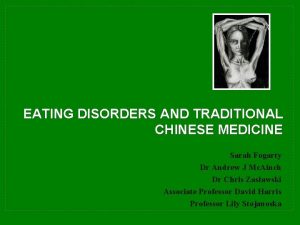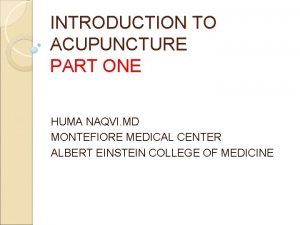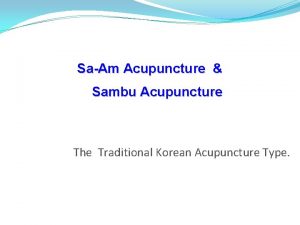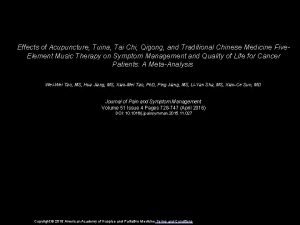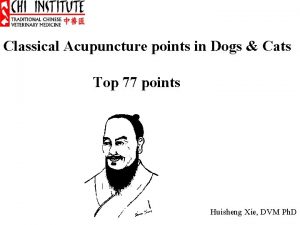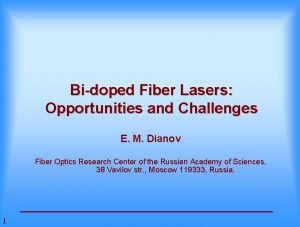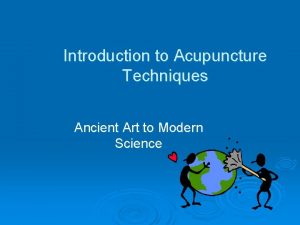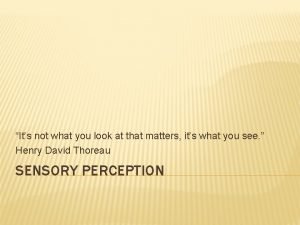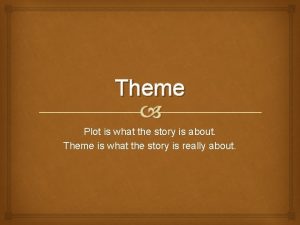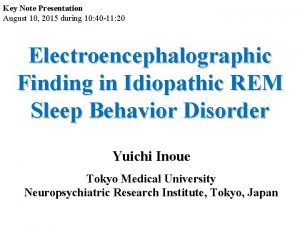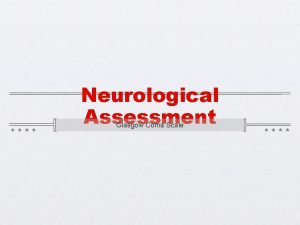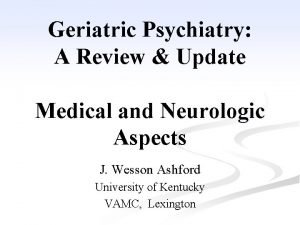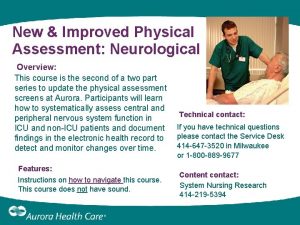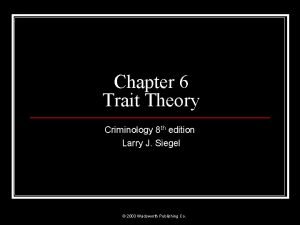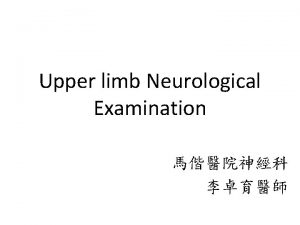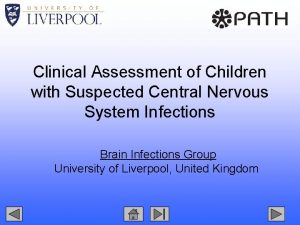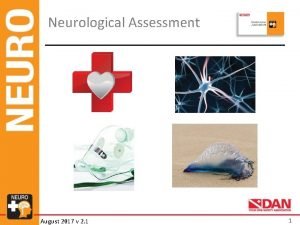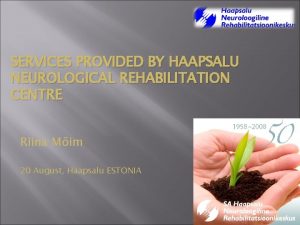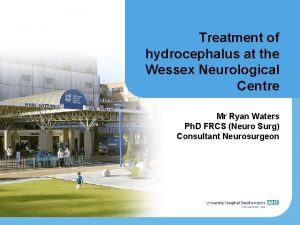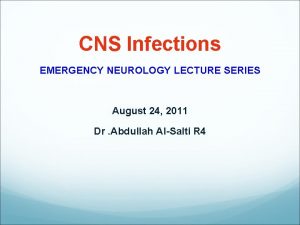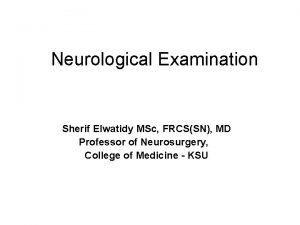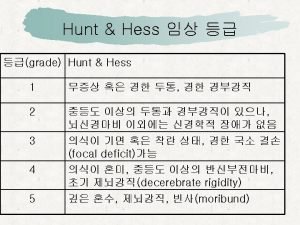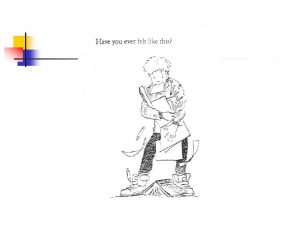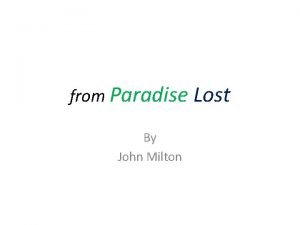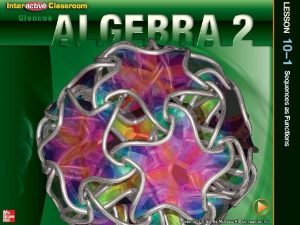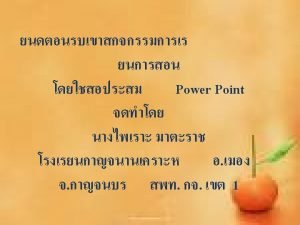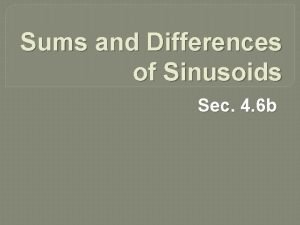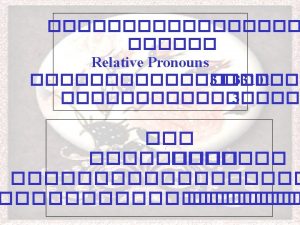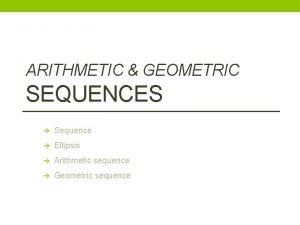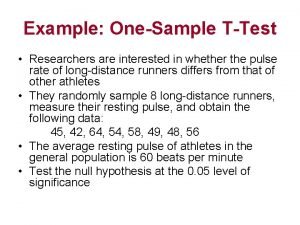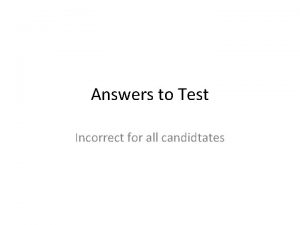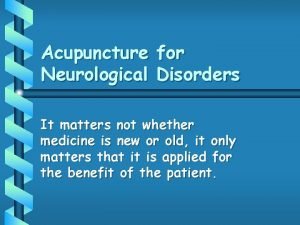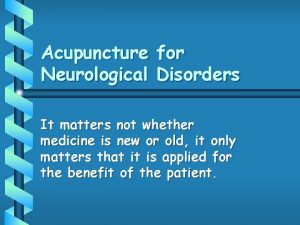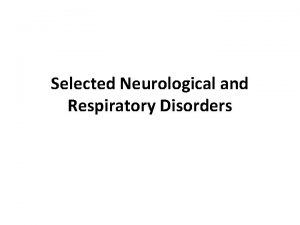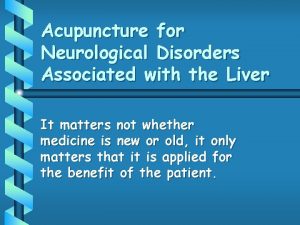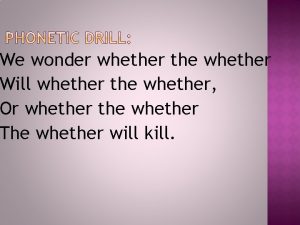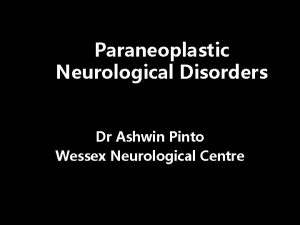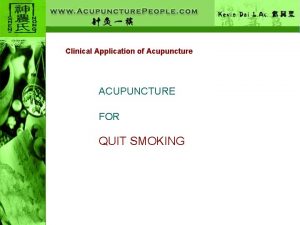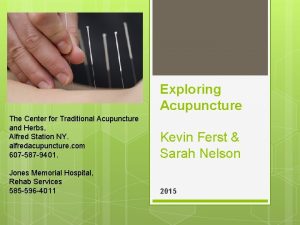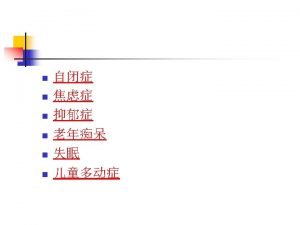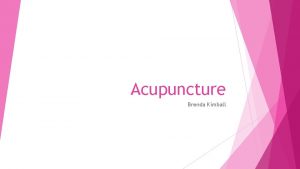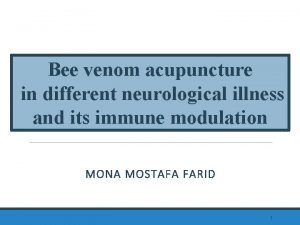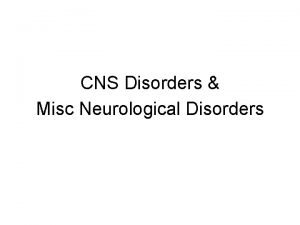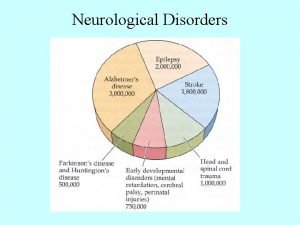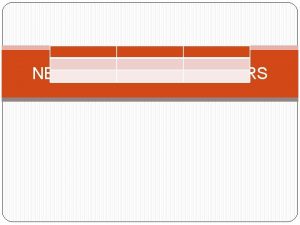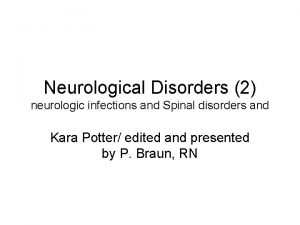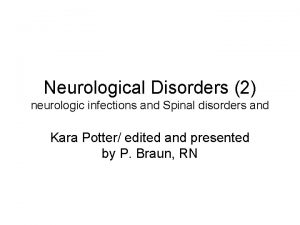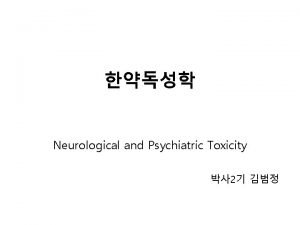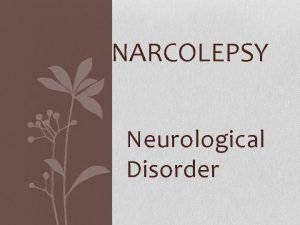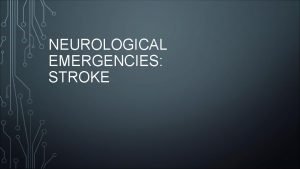Acupuncture for Neurological Disorders It matters not whether

































































































- Slides: 97

Acupuncture for Neurological Disorders It matters not whether medicine is new or old, it only matters that it is applied for the benefit of the patient.

Neurologic Assessment • Is it a neurologic disease? – Seizures – Intention tremor – CN deficits • Head tilt • Nystagmus – CP deficits – Dysmetria – Paralysis

Minimum Database • CBC • Chemistry – Bile acids – Cholinesterase • Urinalysis • Chest and abdominal radiographs • Abdominal ultrasound • Heartworm test • Fecal

Ancillary Neurologic Tests • Electrodiagnostics • Radiographs • CSF tap & analysis • Muscle Analysis – – – – EEG EMG BAER Cells & protein Pressure Cholinesterase Titers – – – – Skull & spinal films Myelography CT scan MRI Enzymes 2 M antibody Anti-ACH receptor antibody – Biopsy

When all else fails… Look at the patient!!!

Outcome of Neurologic Assessment • Localization of Lesion • Def (Qi, Yin, Blood) O • • • A M N N I I I T T V • • • Jing Def (Qi, Yin, Blood, Yang) Def (Qi, Yin, Blood) Stagnation (Blood) Jing Def/Excess or Def Phlegm Fire Trauma Excess or Def Wind Phlegm

Plan • Problem List – ? • Differential Dx – ? • Diagnostic Approach – ? • Treatment – ? P

Seizures in Small Animals • It is estimated that the overall incidence of seizure disorders in dogs and cats is around 1% • In pure breed dogs, this incidence may increase to 1520%, due to the presence of inherited, primary epilepsy in those breeds

Lesion Localization in Seizures • Cerebral Cortex • Diencephalon – Thalamus – Hypothalamus • Mesencephalon

Seizure Diagnoses SEIZURES Primary Epilepsy Secondary Epilepsy Inactive Probably Symptomatic Epilepsy Reactive Epilepsy Active Symptomatic Epilepsy

Seizure Diagnosis • Minimum Database • CT or MRI Scan • CSF tap & analysis • EEG – Abnormal in Reactive Epilepsy – Abnormal in Active Secondary Epilepsy – Abnormal in Secondary Epilepsy • All test are normal in Primary Epilepsy

Asymmetrical Seizures

Licking Seizure

Fly-Biting Seizure

Seizures and Signalment • Primary Epilepsypurebred dogs 1 -3 years of age • Secondary Epilepsyany age but especially under 6 months and over 3 years

Seizures- -TCM • Represent various aspects of the Liver (Wood) system • Excess (3 types) • Deficiency (3 types)

Seizures- -TCM • Excess – Wind-Phlegm • Tongue pale & greasy • Pulse wiry & slippery – Phlegm-Fire • Tongue red & greasy • Pulse rapid, wiry & slippery – Blood Stagnation • Tongue & Pulse like Wind-Phlegm • History of head trauma • Deficiency – Liver Blood Def. • Tongue pale & dry • Pulse weak & thready – Liver & Kidney Yin Def. • Tongue red & dry • Pulse weak & thready – Kidney Jing Def. • Tongue pale or red & dry • Pulse weak & thready • < 1 year of age

Seizures- -TCM • Excess – Wind-Phlegm • expel phlegm, extinguish the wind, open the orifice and stabilize the seizures • Ding Xian Wan – Phlegm-Fire • clear the liver, drain the heat, transform phlegm and open the orifices • Di Tang and Long Dan Xie Gan Tang – Blood Stagnation • expel phlegm, extinguish the wind, open the orifice, stabilize the seizures and invigorate blood • Ding Xian Wan and Tao Hong Si Wu San • Deficiency – Liver Blood Def. • tonify Qi and Blood and quiet the wind • Bu Xue Xi Feng San or Di Tang plus Rehmannia 8 – Liver & Kidney Yin Def. • nourish Yin and extinguish wind • Yang Yin Xi Feng San or Di Tang and Left Side Replenished (Zuo Gui Wan) or Tian Ma Gou Teng plus – Kidney Jing Def. • extinguish the wind astringe or nourish the kidney jing • Di Tang and Epimedium Powder

Epilepsy -- TCM • Internal heat leading to generation of wind • Clear wind & heat and calm the Shen • Points – Constitutional points – Clear wind & heat • GB 20, LI 4, LI 11, GV 14, LIV 3 – Calm the shen • PC 6, HT 7 – Local points • GV 17, GV 20, GV 21, Long hui, GB 9, GB 13, BL 5, GV 1, ST 40 • TCM Herbals – Di Tang (TCM phenobarbital) – Specific herbs for excesses or deficiencies present

Ear Staple • Shen Men – Center of the ear – Staple or point AP can help control 50% of refractor epilepsy cases – Fold ear over & find center on inside

Acepromazine in An Shen • An Shen – Half way around the back of the ear – Aim toward the opposite base of lips – Inject 0. 1 -1 mg diluted with saline to 0. 5 -6 ml

Basic Antioxidants Dogs • Vitamin E 10 IU/lb daily • Vitamin C 5 -10 mg/lb twice a day • Selenium 2 µg/lb daily • Beta carotene 250 IU/lb daily • B Complex 2 mg/kg twice a day Cats • Vitamin E 100 -400 IU daily • Vitamin C 100 -250 mg twice a day • Selenium 50 µg daily • Vitamin A 1000 -5000 IU daily • B Complex 10 mg twice a day

Additional Considerations • Probably safe parasite control – – – Interceptor Frontline Top Spot Revolution • Should avoid – – – – Heartgard Proheart 6 Program Sentinel Frontline Spray Advantage Advantix

Additional Considerations • Diet – Low-carbohydrate food • Supplements – Ginkgo biloba • 2 -4 mg/kg q 8 -12 h • Ginkoba or Publix brand – Tofu or Lecithin • 20 mg/kg daily – Acetylcysteine • 25 mg/kg q 8 h qod

Meningoencephalomyelitis • Infectious Diseases – Species Specific • Steroid Response ME (SRME) • Necrotizing Vasculitis (SRMA) • Necrotizing ME (NME) • Granulomatous ME (GME)

Meningoencephalomyelitis • Pain to paresis to plegia • Dx with CSF tap • Spinal radiographs normal • Myelography normal (might be contraindicated)

Meningoencephalomyelitis

CSF Tap • Collection site for seizures is at the cisterna magnum. • Allows analysis for cells, protein and pressure. • Cytology and titers for infectious organisms can be obtained.

Meningoencephalomyelitis • CSF Analysis – may be normal or show increased pressure, protein and/or cells. • CSF Titers – species specific tests – many must be paired with serum titers. CSF cytology form a dog exhibiting a mixed reaction with neutrophils, lymphocytes and macrophages.

Meningoencephalomyelitis • Infection – – – virus rickettsia protozoa fungus bacteria – – GME NME SRMA • Inflammation

GME • Can be: – – – peracute & progressive chronic • In brainstem, tends to be a multifocal inflammatory disorder • Responds temporarily to steroids. Patient with GME presenting with vertical nystagmus, long tract signs, and circling with incoordination.

GME histologically causes multifocal meningoencephalitis due to proliferation of reticulohistiocytic cells. Lesions also show multinucleated giant cells.

Treatment of ME • Depends upon whether infectious or inflammatory • Prednisolone – Find minimum daily dose and then used 2 times MDD QOD • Primor (activated sulfadimethoxine) – 15 mg/kg BID • Doxycycline – 5 -10 mg/kg QD • Herbal Support – Bromelain/Curcumin • 2. 5/5 mg/kg TID

Menigoencephalomyelitis – Wind-Phlegm • expel phlegm, extinguish the wind, open the orifice and stabilize the seizures • Ding Xian Wan – Phlegm-Fire • clear the liver, drain the heat, transform phlegm and open the orifices • Di Tang and Long Dan Xie Gan Tan

Brain Abscess in a Foal

Brain Abscess in a Foal

Vestibular Disease • Cardinal Signs – Head Tilt – Nystagmus • • Horizontal Rotatory Vertical Positional – Circling (tight) – Imbalance & Incoordination

Vestibular Disease 8 th Nerve only Idiopathic V. D. 8 th Nerve, 7 th Nerve & Horner’s Syndrome Inner Ear Disease Brainstem V. D. Anything Else Central V. D. Cerebellar Disease

Idiopathic Vestibular Disease • Acute Onset of Vestibular Signs – Head tilt – Horizontal or Rotatory nystagmus with fastphase away from head tilt – Nothing else • Can Be Very Severe • Acute, regressive disease

Idiopathic Vestibular Disease -- TCM • Wind (heat) invasion • Clear wind & heat and calm the Shen • Points – Constitutional points – Clear wind & heat • GB 20, LI 4, LI 11, GV 14 – Calm Shen • PC 6, HT 7, GV 17, GV 20, GV 21 – Local points • TH 17, TH 18, TH 21, SI 19, GB 2, Er jian, An shen

Inner Ear Disease • 8 th Nerve Signs • 7 th Nerve Signs – ear & lip droop – lack of palpebral reflex – nose turn – nostril flaring • Horner’s Syndrome

Horner’s Syndrome • Small Animals – – – Ptosis Myosis Enophthalmos • Large Animals – Facial sweating (horse) – Lack of muzzle sweating (cow)

Inner Ear Disease • Most cases are secondary to bacterial infection (otitis media & interna) – extension from otitis externa – pharyngitis with extension up the Eustachian tube – hematogenous spread

Ear Polyps in Cats • Benign growth in the external ear canal which causes signs by extension. • Can also be pharyngeal mass which grows into middle ear via the Eustachian tube.

Ear Polyps in Cats • Treatment is surgical removal. • Damage can be permanent, if pressure necrosis has destroyed the inner ear structure.

Inner Ear Disease -- TCM • Invasion of external pathogen leading to wind, heat, damp. • Heat boils the fluids leading to the accumulation of phlegm. • Quiet the wind, reduce heat, disperse damp and activate the blood to dissolve stagnation.

Inner Ear Disease -- TCM • Points – Constitutional points – Clear wind & heat • GB 20, LI 4, LI 11, GV 14 – Calm the shen • PC 6, HT 7, GV 17, GV 20, GV 21 – Eliminate damp • SP 9 – Activate Qi & blood • ST 36, ST 40, Xin shu – Local points • TH 17, TH 18, TH 21, SI 19, GB 2, Er jian, An shen

Central Vestibular Disease • Postural Changes – CP Deficit – Dysmetria • Reflex Changes – hyperactive reflexes – crossed-extensor reflexes – Babinski’s sign Conscious proprioceptive deficit may be on the same or opposite side of the lesion.

Central Vestibular Disease • CSF Analysis – may be normal or show increased pressure, protein and/or cells. • CSF Titers – species specific tests – many must be paired with serum titers. CSF cytology form a dog exhibiting a mixed reaction with neutrophils, lymphocytes and macrophages

Central Vestibular Disease • Inflammatory or Infectious Diseases – canine distemper – toxoplasmosis and neosporiosis – fungal – rickettsial – GME – SRME

Central Vestibular Disease • Trauma or Vascular – remember dogs don’t get atherosclerosis ! • Neoplasia – meningiomas – choroid plexus papillomas – oligodendrogliomas – astrocytomas – metastatic neoplasia

Central Vestibular Disease MRI of Cerebellar Meningioma

Central Vestibular Disease • Infectious Diseases – – FIP Fe. LV toxoplasmosis cryptococcosis • Trauma • Metabolic – thiamine deficiency • Toxicity – organophosphates • Neoplasia – meningiomas

Central Vestibular Disease -- TCM • Can be wind, heatdamp or wind cold based upon the causative factor involved. • Points – – – Constitutional 8 Principle Zang-Fu

IVD- -TCM Diagnosis • Represents a “bi” syndrome often accompanied by “wei” syndrome • Under domain of KID (bones) & LIV (joints & free flow of qi & blood)

IVD- - TCM Patterns • Excess types • Deficient types – Wind-Cold-Damp – Yang deficiency – Blood stagnation – Yin deficiency – Yin & Yyang deficiency

Fibrocartilagenous Emboli • Vascular occlusion from IVD material – IVD herniates into the venous sinus or the vertebral body – the venous sinuses have no valves – increased pressure forces material into spinal cord

FCE • Generally affects a radicular penetrating branch which leads to a quadrant (wedge) of infarction • Many will improve with time

Schatzie

IVD- -Wind-Cold-Damp • Acute invasion of external pathogen leading to stagnation (cold slows blood flow which is worsened by accumulation of damp) • Tongue – Greasy • Pulse – Slow & soft • Rx principle – Dispel W-C-D, activate blood & relieve stagnation • TCM herbal – Xiao Huo Luo Dan • Acupuncture – Hua-tuo-jia-ji, BL 23, BL 67, GB 39, GV 1, & GV 14

Acute Spinal Cord Injury • Damage affects the vascular supply leading to ischemia • The ischemia leads to lactic acidosis and lipid peroxidation which furthers the injury

Pathology of Spinal Injury • Within 5 minutes there are petechiations in the grey matter • Progresses to complete hemorrhagic necrosis of the grey matter by 4 hours

Pathology of Spinal Injury • From 4 -24 hours there is progressive local extension to involve the white matter. • If force is great enough, then progresses up & down spinal cord

Treatment of Acute SPI • Antioxidant steroids (Solu Medral or Solu Delta Cortef) – 30 mg/kg – 15 mg/kg every 8 hours for 24 -48 hours • Surgical correction Acupuncture needle in wei jian (tip of tail)

Intervertebral Disc Disease: chondrodystrophic dogs • Collagen fibers of the nucleus pulposus metamorphs into hyalin cartilage • IVD looses elasticity and leads to damage of annulus fibrosus

IVD- -chondrodystrophy • Annulus ruptures extruding degenerate nuclear material into the neural canal • This leads to pain, paresis or paralysis

IVD- -Pain Only • Cage Rest for 30 days or 3 weeks after patient becomes clinically normal. • Acupuncture • Oral steroids and diazepam only under supervision

IVD- -Paresis • Hospitalize – Prednisolone (2 mg/kg divided 2 -3 times a day) – Misoprostol 3 -4 µg/kg twice a day – Diazepam 0. 25 -0. 5 mg/kg TID • Should improve in first 5 -7 days

IVD- -Paralysis with Deep Pain • Emergency – Give Solu Medral or Solu Delta Cortef 30 mg/kg – Refer • May observe for 24 hours to see if dramatic improvement – If none, Emergency

IVD- -Paralysis No Deep Pain • Emergency – Give 30 mg/kg Solu Medral or Solu Delta Cortef – Refer • 75% respond in first 24 hours • 50% in first 72 hours • 25% after that

Integrative Therapy of IVD Disease • Acute IVD Disease is a surgical emergency – After 72 hours with no deep pain, the chances are no different – Even with no deep pain there is a 75% • Chronic IVD chance of success Disease may within the 1 st 24 respond poorly to hours & 50% chance in the 1 st surgery 72 hours

Hemilaminectomy • The thinned lamina is further removed and the laminectomy expanded with rongeurs exposing the spinal cord • The area is probed for the problem IVD material

IVD • After surgery, healing is needed • Physical therapy – – – Passive movements Massage Standing exercises Hydrotherapy Walking • Acupuncture – Control pain – Stimulate nerves • Magnet therapy – North pole magnet stimulates nerve regeneration • Healing touch

IVD- -Diet • Basic antioxidants – Vitamin E, vitamin C, vitamin B complex, selenium, beta carotene • Anti-inflammatory membrane stabilizers – Omega-3 -fatty acids, gamma linolenic acid, coenzyme Q-10 • Lecithin to help support myelination • Herbal medications to help immune system – Astragalus, cordyceps mushroom, garlic • Dietary cartilage

IVD- -Prevention • Diet & weight control – Low carbohydrate diet – Basic antioxidants • Chiropractic care • Massage • Exercise

Hans

Hans • Routine radiographs showed a narrowed IVD space at T 11 -12 with a cloudy IV foramen • Incidentally there was calcification of T 13 -L 1

Hans

IVD- -Blood Stagnation • Most common type in chondrodystrophic dogs – KID Jing deficiency leads to failure to nourish LIV leads to joint problems & stagnation • Tongue – Purple • Pulse – Wiry or Fast • Rx Principle – Activate blood, dissipate stagnation and resolve stasis • TCM herbal – Da huo luo dan (Double P formula #2) • Acupuncture – Hua-tuo-jia-ji, BL 23, BL 11, GB 39, GV 14, Wei jian, GV 6, GV 1, & LIV 3

Cervical Spondylomyelopathy • Young Great Danes and older Doberman Pinchers – Young dogs is due to misarticulation and spondylolithesis – Older dogs is due to IVD disease and ligamentous hypertrophy

LS Stenosis- -Cardinal Signs • LS Back Pain – pain on palpation at LS junction – pain on raising the tail head • Diminished tail movement • Urinary and Fecal continency problems

LS Stenosis

LS Stenosis- -Diagnosis • EMG – fibrillation potentials and positive sharp waves caudal to LS junction, distal limb and tail • Imaging techniques – CT Scan – MRI Scan

IVD- -Yang Deficient • Old age leads to KID deficiency – General weakness & cold back • Tongue – Pale & wet with teeth • Pulse (swollen marks) – Deep & weak • Rx principle – Nourish Yang & warm KID • TCM herbal – Sang ji sheng san (lorathus powder) • Chronic IVD

IVD- -Yin Deficiency • Chronic illness or old age consumes KID Yin • Rx principle – Nourish Yin & tonify KID – Weakness in back worse at night • TCM herbal – Red & dry • Chronic IVD • Tongue • Pulse – Deep, thready & weak – Di gu pi san

Discospondylitis • Infection of the intervertebral space • Common causes – – – Staph. aureus Strep. sp. Corynebactrium • Signs – Pain (can be extreme) – Ataxia to plegia

Discospondylitis • Diagnosis can be made on plain radiographs – May initially be normal, until 2 -3 weeks of incubation • Find organism via – Blood culture – Urine culture

Discospondylitis • Also consider – Nocardia or other fungal cause (aspergillosis) – Brucella canis – Spirocerca lupi • Treatment (6 -8 wk) – Cephalosporins – Sulfa drugs

Moose • 9 year old M/C Labrador • HBC 4 months ago – Recovered • Chronic, progressive paresis over 2 weeks

Moose- -Myelogram

Moose- -Surgical Observation Abnormal articular process at T 12 Epidural mass

Moose- -Cytology • Impression smears from both the articular process and the epidural mass revealed PMN with intracellular bacteria

Moose- -CT scan

Moose- -Post OP • Antibiotics – Sulfadimethoxine (Primor) 15 mg/kg q 12 h – Cephalexin 22 mg/kg every 8 hours – Use for 6 -8 weeks

IVD- -Yin & Yang Def. • Aging leads to KID • Rx Principle Yang & Yin – Nourish Yin & tonify KID deficiency – decreases • TCM herbal resistance & allows low grade infection to start • Tongue – Pink or pale • Pulse – Deep & weak – Double P #1 (hindquarter formula) • Very chronic


Conclusions • Acupuncture can help treat or control a number of neurologic diseases • Point selection depends upon the constitution of the animal and the nature and location of the disease • Patience is still a virtue with neurologic conditions
 Acupuncture for eating disorders
Acupuncture for eating disorders Weather and whether
Weather and whether Acupuncture for incontinence
Acupuncture for incontinence Dr huma naqvi
Dr huma naqvi Saam korean
Saam korean Kung fu panda acupuncture
Kung fu panda acupuncture Liv3lo
Liv3lo Al500 acupuncture laser
Al500 acupuncture laser Ancient arts acupuncture
Ancient arts acupuncture It's not what you look at that matters, it's what you see.
It's not what you look at that matters, it's what you see. Beyond this place of wrath and tears meaning
Beyond this place of wrath and tears meaning Neurological disease
Neurological disease Glasgow coma scale video
Glasgow coma scale video Neurological examination
Neurological examination Neuro checks pupil size
Neuro checks pupil size The major premise of the biochemical theory is that
The major premise of the biochemical theory is that Grading of reflexes
Grading of reflexes Uw neurosurgery residents
Uw neurosurgery residents Muscle power neurological examination
Muscle power neurological examination Motor function neurological assessment
Motor function neurological assessment Solent nhs physiotherapy
Solent nhs physiotherapy Haapsalu neurological rehabilitation centre
Haapsalu neurological rehabilitation centre Wessex neurological centre
Wessex neurological centre Neurological exam
Neurological exam Neurological assessment chart
Neurological assessment chart What is focal neurological signs
What is focal neurological signs Fudoscopy
Fudoscopy Neurological based behavior
Neurological based behavior Wfns score
Wfns score Contrasting acquisition
Contrasting acquisition Is adhd a neurological disorder
Is adhd a neurological disorder Uncontrolled, lacking in restraint
Uncontrolled, lacking in restraint Fallen cherub to be weak is miserable
Fallen cherub to be weak is miserable Whether you see it or not
Whether you see it or not A.determine whether the sequence is arithmetic
A.determine whether the sequence is arithmetic Decide whether the relative pronoun is correct or not.
Decide whether the relative pronoun is correct or not. Sum of sinusoids
Sum of sinusoids Decide whether the relative pronouns must be used or not
Decide whether the relative pronouns must be used or not Recursive formula for arithmetic sequence
Recursive formula for arithmetic sequence Difference between independent and one sample t test
Difference between independent and one sample t test The decorated roof of the ancient palace was
The decorated roof of the ancient palace was Särskild löneskatt för pensionskostnader
Särskild löneskatt för pensionskostnader Blomman för dagen drog
Blomman för dagen drog Ekologiskt fotavtryck
Ekologiskt fotavtryck Borra hål för knoppar
Borra hål för knoppar Bris för vuxna
Bris för vuxna Mat för idrottare
Mat för idrottare Argument för teckenspråk som minoritetsspråk
Argument för teckenspråk som minoritetsspråk Ledarskapsteorier
Ledarskapsteorier Publik sektor
Publik sektor Indikation för kejsarsnitt på moderns önskan
Indikation för kejsarsnitt på moderns önskan Datorkunskap för nybörjare
Datorkunskap för nybörjare Plagg i rom
Plagg i rom Iso 22301 utbildning
Iso 22301 utbildning Steg för steg rita
Steg för steg rita Ministerstyre för och nackdelar
Ministerstyre för och nackdelar Redogör för vad psykologi är
Redogör för vad psykologi är Geometriska former i förskolan
Geometriska former i förskolan Bästa kameran för astrofoto
Bästa kameran för astrofoto Tillitsbaserad ledning
Tillitsbaserad ledning Nyckelkompetenser för livslångt lärande
Nyckelkompetenser för livslångt lärande Olika rim dikter
Olika rim dikter Tidbok för yrkesförare
Tidbok för yrkesförare Handledning reflektionsmodellen
Handledning reflektionsmodellen Orubbliga rättigheter
Orubbliga rättigheter Verktyg för automatisering av utbetalningar
Verktyg för automatisering av utbetalningar Big brother rösta
Big brother rösta Kanaans land
Kanaans land Cellorov
Cellorov Jag har nigit för nymånens skära text
Jag har nigit för nymånens skära text Ro i rom pax
Ro i rom pax Boverket ka
Boverket ka Ledningssystem för verksamhetsinformation
Ledningssystem för verksamhetsinformation Novell typiska drag
Novell typiska drag Varför kallas perioden 1918-1939 för mellankrigstiden
Varför kallas perioden 1918-1939 för mellankrigstiden Stål för stötfångarsystem
Stål för stötfångarsystem Tack för att ni har lyssnat
Tack för att ni har lyssnat Shaktismen
Shaktismen Cks
Cks Läkarutlåtande för livränta
Läkarutlåtande för livränta Inköpsprocessen steg för steg
Inköpsprocessen steg för steg Påbyggnader för flakfordon
Påbyggnader för flakfordon Strategi för svensk viltförvaltning
Strategi för svensk viltförvaltning A gastrica
A gastrica Egg för emanuel
Egg för emanuel Varians
Varians Rutin för avvikelsehantering
Rutin för avvikelsehantering Klassificeringsstruktur för kommunala verksamheter
Klassificeringsstruktur för kommunala verksamheter Myndigheten för delaktighet
Myndigheten för delaktighet Tack för att ni lyssnade
Tack för att ni lyssnade Tes debattartikel
Tes debattartikel Tobinskatten för och nackdelar
Tobinskatten för och nackdelar Tack för att ni lyssnade bild
Tack för att ni lyssnade bild En lathund för arbete med kontinuitetshantering
En lathund för arbete med kontinuitetshantering Tack för att ni har lyssnat
Tack för att ni har lyssnat Vad är referatmarkeringar
Vad är referatmarkeringar Mitos steg
Mitos steg Byggprocessen steg för steg
Byggprocessen steg för steg
